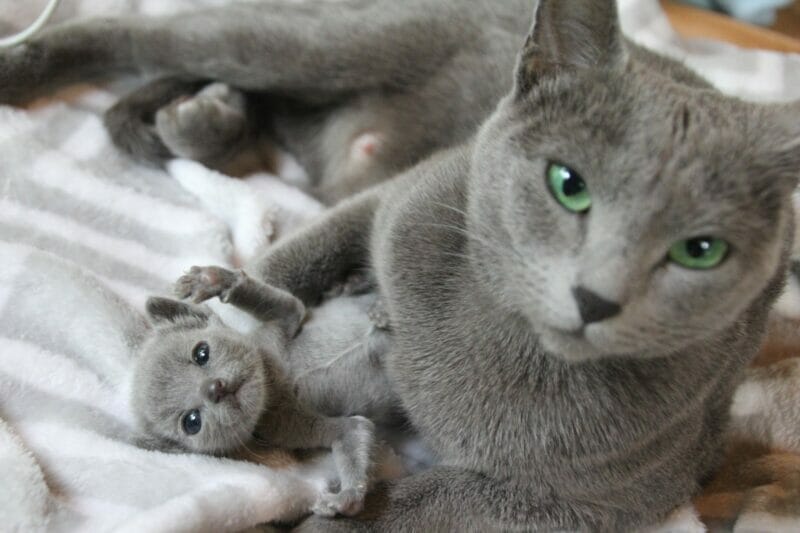Originating from Russia, the Russian Blue Cat is a captivating and enigmatic feline breed that has captured the hearts of cat enthusiasts globally. The breed’s origins can be traced back to the port city of Arkhangelsk, where it was believed to have been brought from the Archangel Isles by sailors.
This beautiful and elegant cat is characterized by its short, dense, plush coat, which is typically a silvery-blue color, giving it a regal appearance. Renowned for its gentle and affectionate nature, the Russian Blue Cat embodies an ideal balance of playfulness, intelligence, and loyalty.

Affectionate with Family: ⭐⭐⭐⭐
Amount of Shedding: ⭐⭐
General Health: ⭐⭐⭐⭐
Potential for Playfulness: ⭐⭐⭐⭐
Tendency to Vocalize: ⭐⭐
Kid-Friendly: ⭐⭐⭐⭐
Friendly Toward Strangers: ⭐⭐⭐⭐
Easy to Groom: ⭐⭐⭐
Intelligence: ⭐⭐⭐⭐
Pet Friendly: ⭐⭐⭐⭐
List about Russian Blue Cat:
- Appearance: The Russian Blue Cat is a medium-sized cat with a slender, graceful body and striking green eyes. The short, dense coat is plush and has a silvery-blue hue.
- Characteristics: Known for their gentle and calm demeanor, highly intelligent, playful, and affectionate towards their families. They often form strong bonds and are known to follow their humans around the house.
- Popularity: well-liked breed and has gained popularity worldwide for its unique appearance and charming personality.
- Temperament: Have a friendly, gentle, and affectionate temperament, making them great companions for families and individuals alike.
- Lifespan: The average lifespan is around 15 to 20 years with proper care.
- Coat Color: The distinctive coat of the Russian Blue Cat is short, dense, and plush, presenting a silvery-blue or gray coloration.
Is Russian Blue Cat a Mixed Cat Breed or Original Cat Breed? The Russian Blue Cat is an original cat breed. However, it has been used in the development of some mixed breeds, including the Nebelung, Chartreux, and British Shorthair.
How to Take Care
- Food: Providing a balanced diet rich in high-quality protein is essential for a Russian Blue Cat’s well-being. Examples include premium cat food, raw or cooked meat, and specially formulated cat treats. A nutritious diet contributes to their overall health and vitality.
- Environment: Creating a stimulating and comfortable environment is crucial. Essential elements include cozy resting spots, interactive toys, scratching posts, and a secure and quiet space for relaxation. A peaceful environment contributes to their well-being and happiness.
- Grooming: Have a short coat that requires minimal grooming. Regular brushing helps in reducing shedding and maintaining a healthy coat. Additionally, routine nail trimming, dental care, and occasional baths contribute to their overall hygiene.
- Take Care Method: To ensure a happy and healthy Russian Blue Cat, regular playtime, positive reinforcement, and socialization are essential. Providing affection and engaging in interactive activities enrich their lives and strengthen the bond between the cat and its family.

How to Buy/Adopt
- Locations of Popularity: Russian Blue Cats are popular worldwide. They can be found in reputable breeders, animal shelters, and rescue organizations across the United Kingdom, United States, Canada, and various other countries.
- Average Price: The average price can range from $800 to $2,000, depending on factors such as lineage, age, and location.
- Community for Adoption/Rescue: There are several communities and organizations dedicated to the adoption and rescue of Russian Blue Cats. Some prominent ones include “Russian Blue Rescue” in the United States and “Russian Blue Breeders Association” in the United Kingdom.
What to Check Before Adopt/Buy
- General Health: Ensure the cat is in good health and has received appropriate vaccinations.
- Vaccination Status: Confirm that the cat is up-to-date on vaccinations to prevent common feline diseases.
- Medical History: Obtain the cat’s medical history, including any past illnesses or treatments.
How to Prepare for a Cat’s Life:
3 Short Advice Sentences:
- Provide plenty of interactive toys and engage in playtime to keep your Russian Blue Cat mentally and physically stimulated.
- Establish a routine for feeding, grooming, and play to create a sense of security and predictability for your cat.
- Create a safe and comfortable space for your Russian Blue Cat to retreat to, especially if there are other pets or children in the household.
How to Take Care:
- Ensure a balanced diet and provide fresh water daily.
- Maintain a clean litter box and provide regular exercise and mental stimulation.
- Schedule regular veterinary check-ups and vaccinations.
List Some Essential Equipments for Caring:
- Litter box and high-quality cat litter.
- Comfortable cat bed and scratching post.
- Interactive toys and puzzle feeders for mental stimulation.
Common Diseases:
- Respiratory infections, such as feline herpesvirus and calicivirus.
- Urinary tract infections.
- Hypertrophic cardiomyopathy (a heart condition).
Vaccines Necessary:
- Feline viral rhinotracheitis, calicivirus, and panleukopenia (FVRCP) vaccine.
- Rabies vaccine.
- Feline leukemia (FeLV) vaccine for outdoor cats.

Common Names
- Giving your Cat a name is a personal choice. Choose a name that reflects their elegance and grace. Common names for Russian Blue Cats include Luna, Smokey, Bella, Sasha, and Dmitri.
- Typically do not have significant hair loss problems; their short coat sheds minimally. Regular grooming can help manage shedding.
- This comprehensive guide provides valuable insights into the breed, aiding potential cat owners in understanding their needs and characteristics for a harmonious and happy feline-human companionship.
“Do Russian Blue Cats like going out rather than staying home?”
Generally more comfortable and prefer staying indoors in a secure and familiar environment.
“Is a Russian Blue Cat a Smart cat?”
Yes, highly intelligent and quick learners, making them relatively easy to train.
“How many types of Russian Blue Cat?”
Typically refers to a specific type, known for its blue coat and charming personality.
“How to stop Russian Blue Cat Biting?”
Use positive reinforcement, redirect their attention, and provide appropriate chew toys to discourage biting behavior.
“How to stop Russian Blue Cat Scratching?”
Offer scratching posts, provide positive reinforcement when they use it, and use soft nail caps to prevent damage.
“How to do Socialization and Raising Friendly for Russian Blue Cat?”
Start socialization early, expose them to various people and environments positively, and use treats and praise to reinforce good behavior.
“How to Train your Russian Blue Cat?”
Use positive reinforcement, treats, and repetition to train your Cat, focusing on commands like sit, stay, and litter training.
“How long should we check for Russian Blue Cat’s health with a vet?”
Regular check-ups, at least once a year, are recommended to monitor your Cat’s health and catch any potential issues early.
“Are Russian Blue Cats good family pets?”
Yes, make excellent family pets due to their affectionate and gentle nature.
“Are Russian Blue Cats good with children?”
Yes, generally good with children, being gentle and patient, but supervision is always recommended.
“Are Russian Blue Cats good with other animals?”
can get along well with other pets if properly introduced and socialized.
“Can Russian Blue Cats cause allergies?”
Yes, like many other cat breeds, can cause allergies in individuals sensitive to pet dander.
“Are Russian Blue Cats ferocious?”
No, not ferocious. They are gentle, friendly, and typically non-aggressive.
Are you a cat lover who wants to learn more about your furry friends? Do you want to find the best cat food, cat care tips, and resources for your cats? If so, you’ve come to the right place! Welcome to Cat Food Site, the ultimate website for cat enthusiasts.
Can Cats Eat Greek Yogurt? Here you will find everything you need to know about cats Breed, from their health and behavior to their breeds, cat diet and names. You will also discover the latest cat news, cat nutrition, trends, and memes from around the web.

